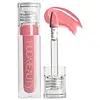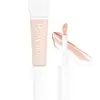Huda Beauty Faux Filler Extra Shine Lip Gloss Versus Huda Beauty GloWish Bright Light Hydrating Sheer Vegan Concealer
What's inside
What's inside
 Key Ingredients
Key Ingredients

 Benefits
Benefits

 Concerns
Concerns

No concerns
 Ingredients Side-by-side
Ingredients Side-by-side

Octyldodecanol
EmollientHydrogenated Polyisobutene
EmollientBis-Diglyceryl Polyacyladipate-2
EmollientDiisostearyl Malate
EmollientVp/Eicosene Copolymer
Diisopropyl Adipate
EmollientC20-40 Alcohols
EmulsifyingVp/Hexadecene Copolymer
Cocoyl Hydrolyzed Collagen
CleansingEthylcellulose
Silica Dimethyl Silylate
EmollientAroma
Ethyl Vanillin
MaskingEthylene/Propylene/Styrene Copolymer
Butylene/Ethylene/Styrene Copolymer
Pentaerythrityl Tetra-Di-T-Butyl Hydroxyhydrocinnamate
AntioxidantBHT
AntioxidantIron Oxides
Titanium Dioxide
Cosmetic ColorantCI 15850
Cosmetic ColorantCI 45410
Cosmetic ColorantCI 16035
Cosmetic ColorantBlue 1 Lake
Cosmetic ColorantCI 77742
Cosmetic ColorantCI 19140
Cosmetic ColorantOctyldodecanol, Hydrogenated Polyisobutene, Bis-Diglyceryl Polyacyladipate-2, Diisostearyl Malate, Vp/Eicosene Copolymer, Diisopropyl Adipate, C20-40 Alcohols, Vp/Hexadecene Copolymer, Cocoyl Hydrolyzed Collagen, Ethylcellulose, Silica Dimethyl Silylate, Aroma, Ethyl Vanillin, Ethylene/Propylene/Styrene Copolymer, Butylene/Ethylene/Styrene Copolymer, Pentaerythrityl Tetra-Di-T-Butyl Hydroxyhydrocinnamate, BHT, Iron Oxides, Titanium Dioxide, CI 15850, CI 45410, CI 16035, Blue 1 Lake, CI 77742, CI 19140
Water
Skin ConditioningC9-12 Alkane
SolventDicaprylyl Ether
EmollientUndecane
EmollientPropanediol
SolventDicaprylyl Carbonate
EmollientPolyglyceryl-6 Polyricinoleate
EmulsifyingPentylene Glycol
Skin ConditioningVaccinium Myrtillus Seed Oil
Skin ConditioningTridecane
PerfumingVp/Hexadecene Copolymer
Zinc Stearate
Cosmetic ColorantDisteardimonium Hectorite
StabilisingCaffeine
Skin ConditioningOpuntia Ficus-Indica Stem Extract
Skin ConditioningPrunus Amygdalus Dulcis Oil
Skin ConditioningSodium Hyaluronate
HumectantTocopherol
AntioxidantPolyglyceryl-2 Isostearate
EmulsifyingMica
Cosmetic ColorantCoco-Caprylate/Caprate
EmollientMagnesium Sulfate
Octyldodecanol
EmollientSodium Dehydroacetate
PreservativeLecithin
EmollientGlycerin
HumectantSodium Benzoate
MaskingSynthetic Fluorphlogopite
Potassium Sorbate
PreservativeHydrogenated Lecithin
EmulsifyingAscorbyl Palmitate
AntioxidantStearic Acid
CleansingCitric Acid
BufferingTin Oxide
AbrasiveCI 77491
Cosmetic ColorantIron Oxides
Titanium Dioxide
Cosmetic ColorantWater, C9-12 Alkane, Dicaprylyl Ether, Undecane, Propanediol, Dicaprylyl Carbonate, Polyglyceryl-6 Polyricinoleate, Pentylene Glycol, Vaccinium Myrtillus Seed Oil, Tridecane, Vp/Hexadecene Copolymer, Zinc Stearate, Disteardimonium Hectorite, Caffeine, Opuntia Ficus-Indica Stem Extract, Prunus Amygdalus Dulcis Oil, Sodium Hyaluronate, Tocopherol, Polyglyceryl-2 Isostearate, Mica, Coco-Caprylate/Caprate, Magnesium Sulfate, Octyldodecanol, Sodium Dehydroacetate, Lecithin, Glycerin, Sodium Benzoate, Synthetic Fluorphlogopite, Potassium Sorbate, Hydrogenated Lecithin, Ascorbyl Palmitate, Stearic Acid, Citric Acid, Tin Oxide, CI 77491, Iron Oxides, Titanium Dioxide
 Reviews
Reviews

Ingredients Explained
These ingredients are found in both products.
Ingredients higher up in an ingredient list are typically present in a larger amount.
Octyldodecanol is a fatty alcohol. It is primarily used to enhance the texture of products.
As an emulsifier, Octyldodecanol helps prevent the oils and waters from separating. It also prevents ingredients from creating foam when shaken.
Octyldodecanol is created by reducing fatty acid to an alcohol.
Due to its high molecular weight, it does not get absorbed into the skin.
Learn more about OctyldodecanolTitanium dioxide is a mineral UV filter widely used in sunscreens and cosmetics.
It is one of only two UV filters officially classified as “mineral” by regulatory agencies, the other being zinc oxide.
Titanium dioxide provides broad-spectrum protection mostly in the UVB and UVAII range, with some protection in the UVAI range.
While its UVA protection isn’t as strong as zinc oxide’s, the difference is minor.
A common myth is that mineral UV filters reflect UV light. However, modern research shows titanium dioxide absorbs UV radiation like chemical filters (~95% absorption & 5% reflection).
Thanks to its non-irritating nature, titanium dioxide is suitable for sensitive, acne-prone, or redness-prone skin. It is unlikely to cause "eye sting" like other sunscreen ingredients.
A major drawback of this ingredient is its white cast and thick texture. This is why mineral sunscreens often leave a white cast and are less cosmetically elegant than chemical/hybrid sunscreens.
To improve white cast and spreadability, micronized or nano-sized titanium dioxide is often used.
There are ongoing concerns surrounding nano-titanium oxide's impact on marine ecosystems.
There is no conclusive evidence that any form of titanium oxide (or any other sunscreen ingredients) will cause harm to marine ecosystems or coral reefs. The science is still developing but many consumers are keeping a close eye on this issue.
Please note, many destinations have reef-safety sunscreen rules. For instance, the U.S. Virgin Islands advises all visitors to use non-nano mineral sunscreens.
Nano mineral sunscreens once raised safety concerns about absorption into skin.
Extensive research has shown that they do not penetrate healthy or damaged skin; they remain safely on the surface and the top layer of dead skin (stratum corneum).
You'll likely find titanium dioxide bundled with alumina, silica, or dimethicone. These ingredients help make titanium dioxide highly photostable; this prevents it from interacting with other formula components under UV light.
Learn more about Titanium DioxideVP/Hexadecene Copolymer is a synthetic film-forming agent. It has both water and oil loving properties, allowing it to create a flexible, even film on the skin.
This ingredient helps enhance texture, smoothness, and wear resistance in makeup products while reducing tackiness.
This ingredient is a combination of red, black, and yellow iron oxide pigments. This combination of colors is usually found in foundation, because it results in a "skin" color.